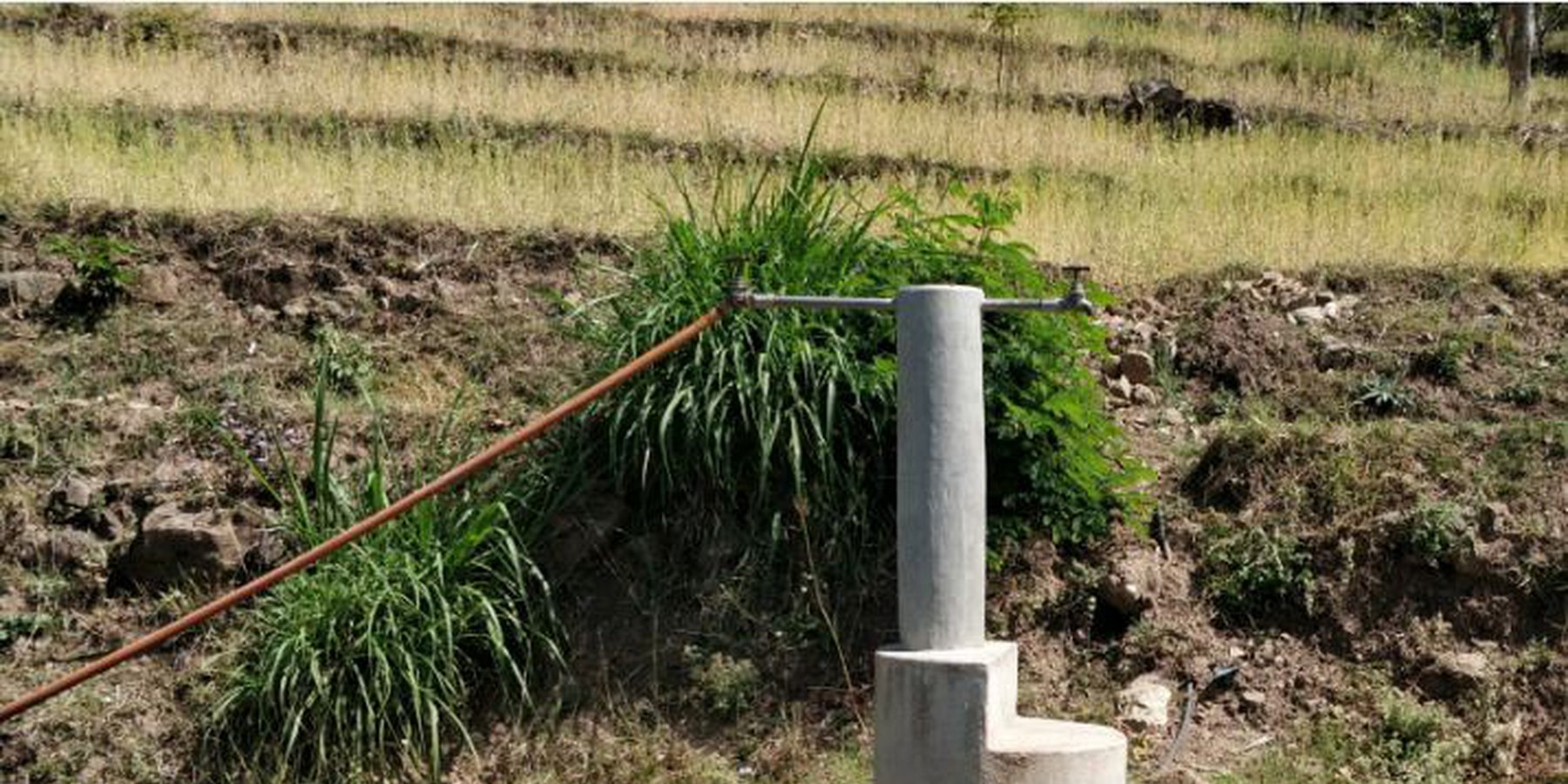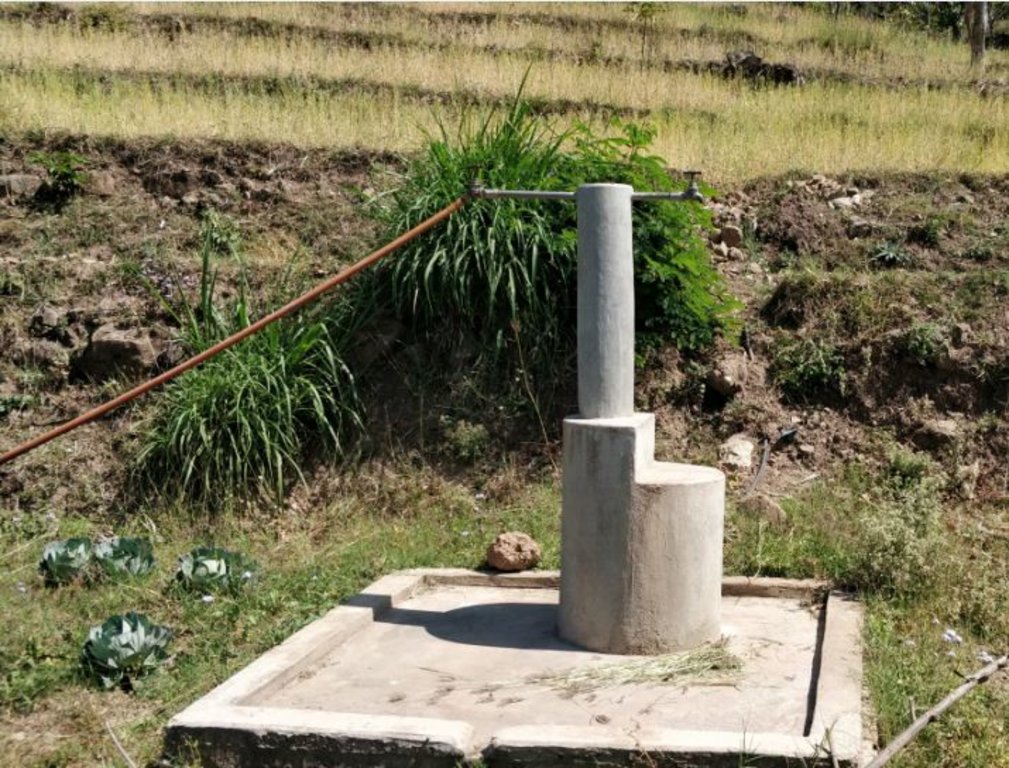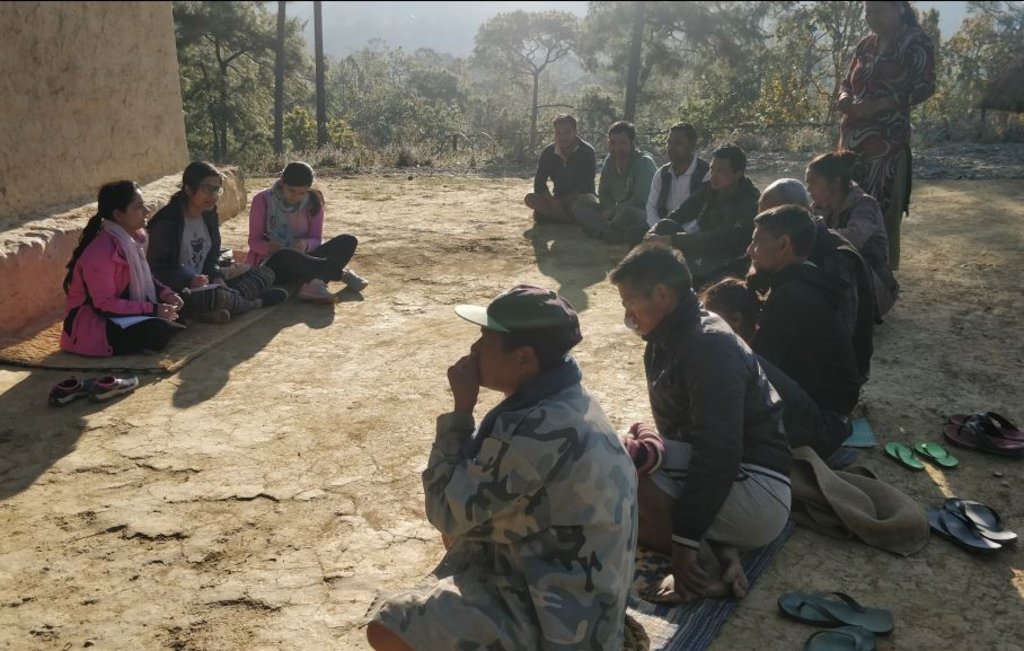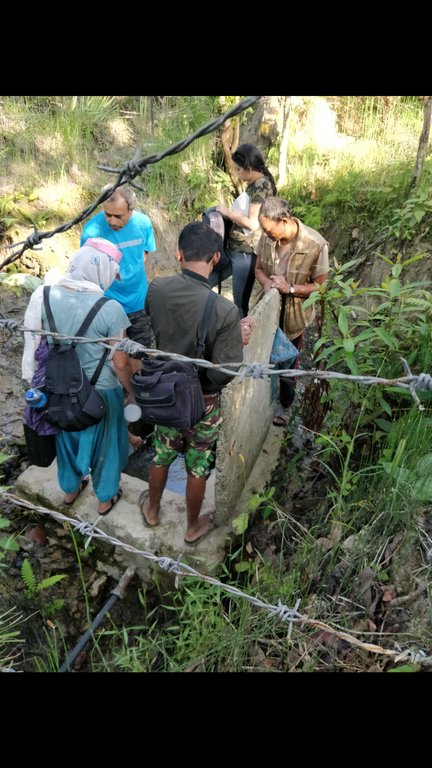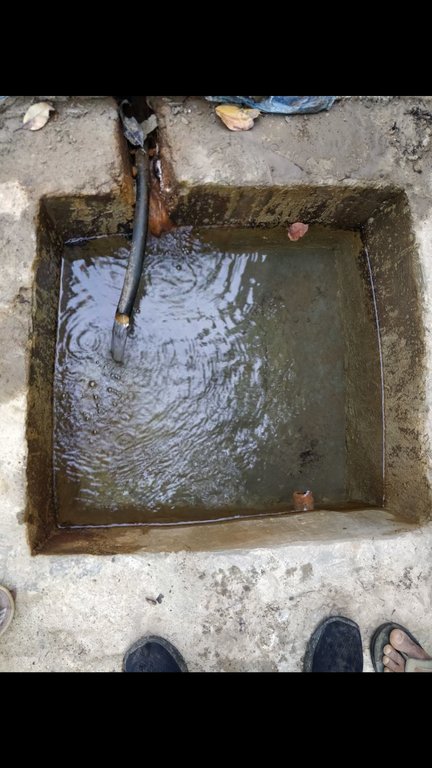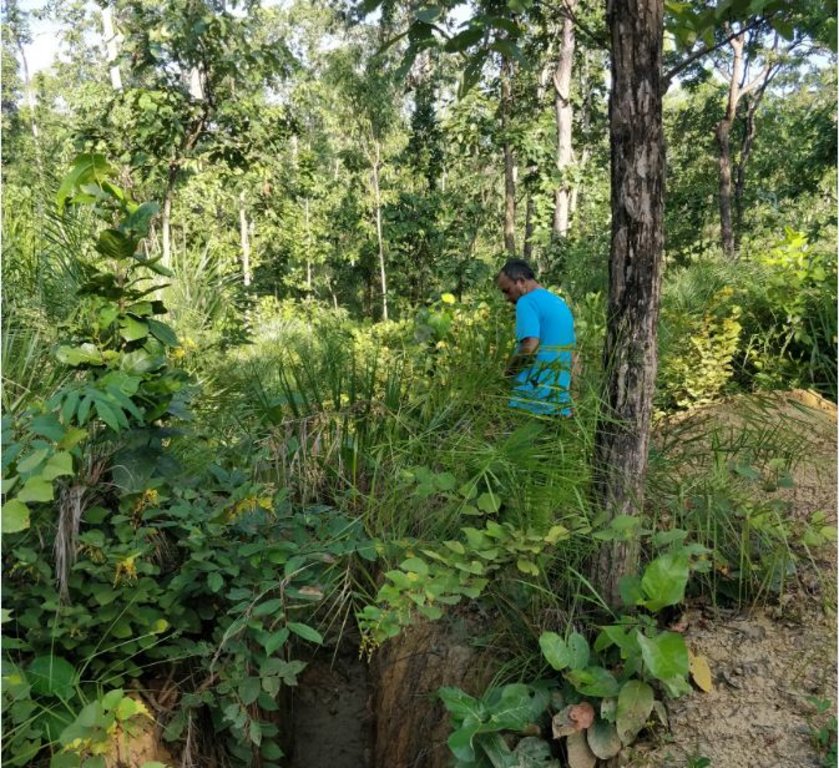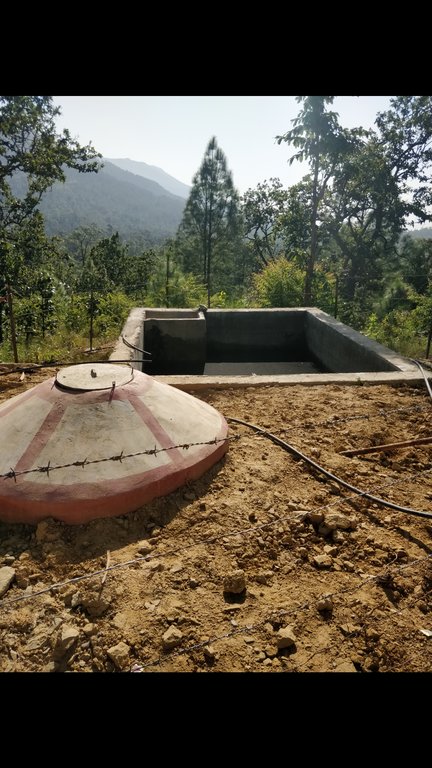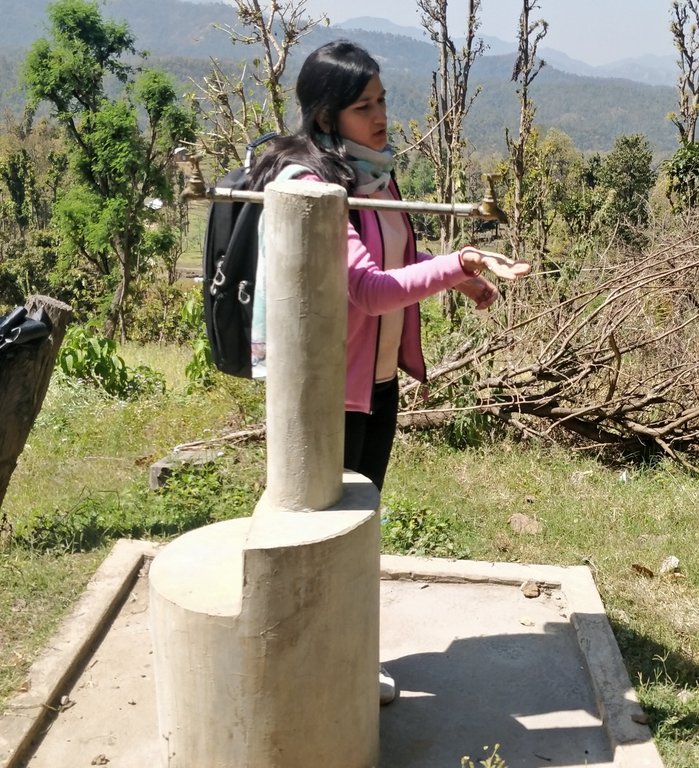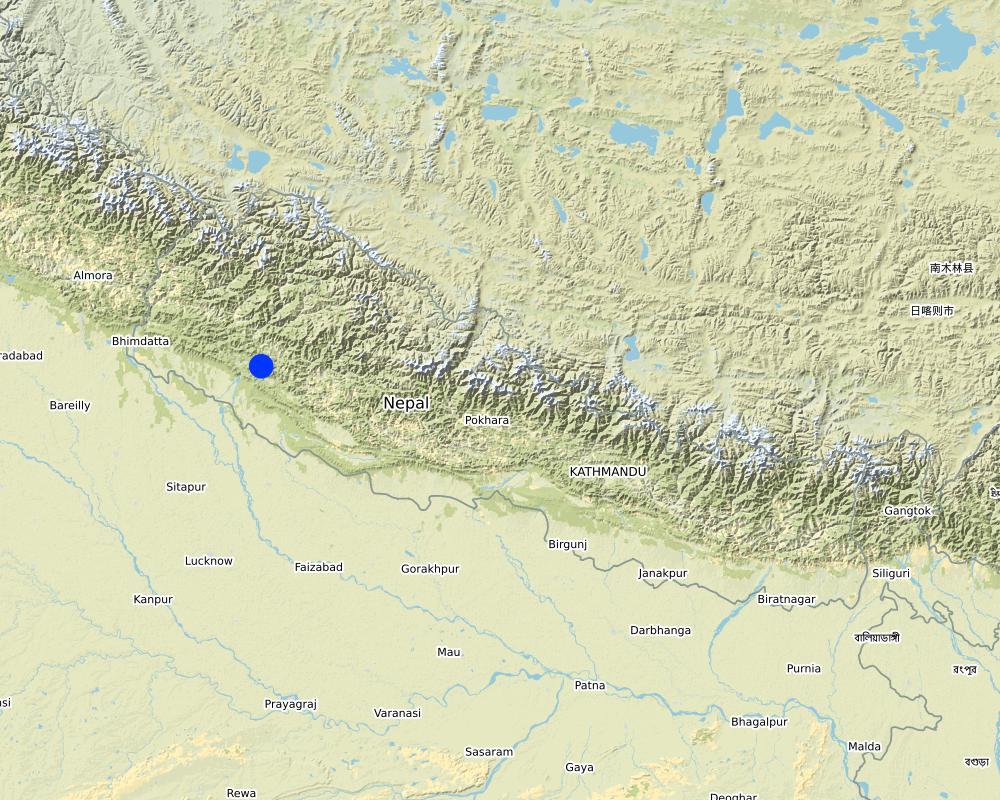Gravity-Fed Multiple Use Water System (MUWS) : Odaltaal [Nepal]
- Creation:
- Update:
- Compiler: Jhuna Kattel
- Editor: –
- Reviewer: Renate Fleiner
Odaltaal Ghaito
technologies_5182 - Nepal
View sections
Expand all Collapse all1. General information
1.2 Contact details of resource persons and institutions involved in the assessment and documentation of the Technology
Key resource person(s)
Water User:
Sunar Kopila
Nepal
Name of project which facilitated the documentation/ evaluation of the Technology (if relevant)
Prospects and challenges of water use systems as climate adaptive option for sustainable water management in Himalayan RegionName of the institution(s) which facilitated the documentation/ evaluation of the Technology (if relevant)
Kathmandu University (KU) - Nepal1.3 Conditions regarding the use of data documented through WOCAT
The compiler and key resource person(s) accept the conditions regarding the use of data documented through WOCAT:
Yes
1.4 Declaration on sustainability of the described Technology
Is the Technology described here problematic with regard to land degradation, so that it cannot be declared a sustainable land management technology?
No
Comments:
The technology used serves as a source of providing water for drinking and other multiple uses; such that it acts as a means to conserve and manage water resources rather than degrade them.
2. Description of the SLM Technology
2.1 Short description of the Technology
Definition of the Technology:
Water from source in hill top is collected in a small reservoir (to preserve natural source), then passes onto a Reservoir Tank (RVT) / Ferro-Cement Tank / "Ghaito" for drinking water with a capacity of 4000L. When the RVT gets filled, water overflows, is collected in another concrete irrigation pond (10,000L) for irrigation. From the ferro-cement tank (Ghaito) and concrete irrigation pond, two pipelines are fed and water supplied into individual tap-system or MUWS tap towers for multiple purposes.
2.2 Detailed description of the Technology
Description:
The technology is applied in a natural environment, i.e. natural water source. The source of water is a natural source of water that sits atop a small hill which is owned by the government. From the source, water is collected in RVT ( for drinking water) and concrete irrigation pond ( for irrigation). PVC pipes are fed onto the tanks to distribute the water for multiple purposes to 4 MUWS tap towers or tap systems or "Thaado". These MUWS tap towers consist of two faucets each- one for drinking and the other for irrigation and other purposes.The major purposes of this technology are to supply clean water for drinking and other multiple purposes through a cheap, effective and simple system. The natural source of water is locally maintained. Operation and maintenance works are not mandatory, however the locals are responsible for maintaining it should the need arise. The system was financed through a public-private-partnership (PPP) program; out of which some amount was funded by a Non-Governmental Organization (NGO)- Sundar Nepal ( NPR. 2,77,000 ), some amount by the Village Development Committee (VDC)- (NPR. 2,63,000), and the remaining amount was collected by a locals’ group (NPR. 60,000). For establishing the system, labor and construction materials were needed for building the tanks and pipeline systems. For the maintenance, manual labor is necessary. The quality of the water that is supplied to the households is good and the quantity seems sufficient for the 19 households. Sustainable use of water resources through a MUWS system, cheap and effective way to conserve water resources, ensuring availability of clean water even through dry seasons are some of the technology's advantages. Similarly, clean water, more water for irrigation for vegetable farming, simplifying day-to-day life are some of the strengths of the technology. Dislikes could be the limited availability of water during the dry season and that out of 4 systems only 2 are in operation and the other ones are in a non-working condition.
Management system in place for MUWS:
A separate committee is set up for the smooth operation of the system, which consists of 20 members- 10 males and 10 females. The head of the committee is Mrs. Kopila Sunar. The committee conducts a monthly meeting to discuss the problems and need of maintenance. During the initial setup, the connection of pipelines from the tap systems to the reservoir tanks was, however, done with the contribution of the locals. Every month, each family from the 19 households contributes NPR. 100 ( One Hundred Rupees) , which goes to a fund that is set up for the times of need. The labor contribution by the people of the VDC was dependent upon the number and availability of family members in the household. Similarly, the use of the MUWS system and water from it is also dependent upon the availability of family members. Little to no maintenance was done to the system till now from 2075 B.S. ( 1 years) . Equal number of male and female members are in the committee dedicated to the MUWS system.
2.3 Photos of the Technology
2.5 Country/ region/ locations where the Technology has been applied and which are covered by this assessment
Country:
Nepal
Region/ State/ Province:
Province-6, Mid-Western Development Region
Further specification of location:
Kunathari VDC-10, Odaltaal
Specify the spread of the Technology:
- applied at specific points/ concentrated on a small area
Is/are the technology site(s) located in a permanently protected area?
No
Map
×2.6 Date of implementation
Indicate year of implementation:
2018
2.7 Introduction of the Technology
Specify how the Technology was introduced:
- through projects/ external interventions
Comments (type of project, etc.):
Sundar Nepal- a non-governmental organization (NGO) helped with Odaltaal Multiple Use Water Systems
3. Classification of the SLM Technology
3.1 Main purpose(s) of the Technology
- improve production
- reduce, prevent, restore land degradation
- adapt to climate change/ extremes and its impacts
- create beneficial economic impact
- improve water security and increase efficient use at a household level
3.2 Current land use type(s) where the Technology is applied

Cropland
- Annual cropping
- Perennial (non-woody) cropping
Annual cropping - Specify crops:
- cereals - barley
- cereals - maize
- cereals - rice (upland)
- cereals - wheat (spring)
- cereals - wheat (winter)
Perennial (non-woody) cropping - Specify crops:
- areca
- banana/plantain/abaca
- sugar cane
Number of growing seasons per year:
- 3
Specify:
The water used for irrigation is used in fields for 2-3 cycles of crop growing (annual) like rice, maize and barley and into kitchen-farming/tunnel farming (perennial) where vegetables grown are cucumber, tomatoes, chilli, bitterguard, peas, etc.
Is intercropping practiced?
No
Is crop rotation practiced?
Yes
If yes, specify:
Rice, Maize and Wheat are cycled according to the seasons.

Other
Specify:
Drinking Water
Remarks:
Drinking water used directly from the tap systems. Some boil it but most of them use it straight from the tap systems and consume without filtration.
Comments:
Irrigation and Multiple Uses: The locals use the technology in order to irrigate their cropland so that the plant productivity is increased. As well, the introduction of this technology has opened up doors to new possibilities like construction of tunnels ( green houses) so that the locals can grow seasonal and off-seasonal vegetables in their backyards. Animal husbandry has also been an increasing practice. Human uses like washing, cooking, cleaning, bathing, etc are amply sufficient due to adequacy of water from this technology.
3.3 Has land use changed due to the implementation of the Technology?
Has land use changed due to the implementation of the Technology?
- Yes (Please fill out the questions below with regard to the land use before implementation of the Technology)

Cropland
- Annual cropping
- Perennial (non-woody) cropping
Annual cropping - Specify crops:
- cereals - barley
- cereals - maize
Perennial (non-woody) cropping - Specify crops:
- banana/plantain/abaca
Is intercropping practiced?
No
Is crop rotation practiced?
No
Comments:
Before the introduction of the technology, the land productivity was minimal. Water for human uses like bathing, cleaning, washing, cooking, etc. were scarce; especially during the dry seasons. No green houses were constructed. They used to rear very few cattle.
3.4 Water supply
other (e.g. post-flooding):
- Natural source (Mool) of water in foliage atop a hill
Comments:
The supply of water comes from a natural source ( 'mool' in local language) , where a small enclosure is constructed so that the source is preserved and water is amply supplied to the ferrocement RVT for drinking purposes ( 'Ghaito' in local language) and concrete irrigation pond for irrigation purposes.
3.5 SLM group to which the Technology belongs
- water harvesting
- irrigation management (incl. water supply, drainage)
- ground water management
- Gravity Fed Multiple Use Water System (MUWS) , New Scheme
3.6 SLM measures comprising the Technology

structural measures
- S5: Dams, pans, ponds
- S6: Walls, barriers, palisades, fences
- S7: Water harvesting/ supply/ irrigation equipment
- S11: Others
Comments:
The technology is comprised of structural measures, barbed wire fences to surround natural water source, iron lid top, cement enclosure for water source, pipes feeding onto the source, ferro-cement RVT, tap towers, faucets, concrete irrigation pond, etc.
3.7 Main types of land degradation addressed by the Technology

water degradation
- Hs: change in quantity of surface water
- Hp: decline of surface water quality
Comments:
Before setting up the technology, much of the water during dry seasons would evaporate from the natural source ( mool) and there would be scarcity of water during dry seasons. This has been addressed by the technology, where securing the natural source of water prevented evaporation and storing water in enclosed tanks helped supply water during dry seasons.
Similarly, due to no preservation of the source and no storage tanks, the water would be soiled by sediments, wastes and insects' larvae. After setting technology up, the quality of water has vastly improved as well.
3.8 Prevention, reduction, or restoration of land degradation
Specify the goal of the Technology with regard to land degradation:
- prevent land degradation
Comments:
The technology prevents water source degradation, improves perennial water availability, helps tackle with the effects of natural calamities like drought, etc.
4. Technical specifications, implementation activities, inputs, and costs
4.1 Technical drawing of the Technology
Technical specifications (related to technical drawing):
Source: Natural (mool) atop a small hill, secured by wire fences and preserved with concrete and metal lid ( to prevent evaporation).
Water from source collected in Ferro-Cement Tank (RVT) / "Ghaito" in local language, with capacity 4000Ltrs.
Water overflows from RVT into an Irrigation Pond (Open Top, Concrete) with capacity 10,000Ltrs.
PVC Pipes leave the RVT and Pond into 4 MUWS Towers ("Thaado" in local language) to serve 19 households.
One faucet supplies drinking water from RVT and next faucet supplies water for irrigation and other multiple purposes (drip irrigation, tunnel farming, etc.).
4.2 General information regarding the calculation of inputs and costs
Specify how costs and inputs were calculated:
- per Technology area
Indicate size and area unit:
5-6 dhurs
If using a local area unit, indicate conversion factor to one hectare (e.g. 1 ha = 2.47 acres): 1 ha =:
1 ha = 590 dhurs
other/ national currency (specify):
NPR
If relevant, indicate exchange rate from USD to local currency (e.g. 1 USD = 79.9 Brazilian Real): 1 USD =:
110.0
Indicate average wage cost of hired labour per day:
N/A ( voluntary labour from each household)
4.3 Establishment activities
| Activity | Timing (season) | |
|---|---|---|
| 1. | Enclosement for the groundwater source | Before rainy season |
| 2. | Construction of Ferro-cement tank for Drinking Water | Before rainy season |
| 3. | Construction of Concrete pond for Irrigation | Before rainy season |
| 4. | Securing the perimeter for the tanks | Before rainy season |
| 5. | Laying down the PVC pipework | Before rainy season |
| 6. | Construction of 4 individual MUWS tap towers ( Thaado in Nepalese language) | During rainy season |
| 7. | Final touch-ups, Setting up faucets, Preliminary checking | During rainy season |
Comments:
A total of 3 months ( roughly 90 days ) was required for the construction of the technology to be complete.
4.4 Costs and inputs needed for establishment
| Specify input | Unit | Quantity | Costs per Unit | Total costs per input | % of costs borne by land users | |
|---|---|---|---|---|---|---|
| Labour | Voluntary by locals | 100.0 | ||||
| Equipment | Irrigation Pond | 1.0 | 275000.0 | 275000.0 | 10.0 | |
| Equipment | Ferrocement Tank ( Ghaito) | 1.0 | 225000.0 | 225000.0 | 10.0 | |
| Equipment | Securing fences, Perimeter securing for tanks and water source | 1.0 | 50000.0 | 50000.0 | 10.0 | |
| Equipment | Setting up MUWS tap towers ( Thaado in local tongue) | 4.0 | 12500.0 | 50000.0 | 10.0 | |
| Equipment | PVC Pipes | 100.0 | ||||
| Total costs for establishment of the Technology | 600000.0 | |||||
| Total costs for establishment of the Technology in USD | 5454.55 | |||||
If land user bore less than 100% of costs, indicate who covered the remaining costs:
1.Village Developmment Committee:NPR. 2,63,000 2.Sundar Nepal NGO: ~ NPR. 2,77,000 3.Water – Users : NPR. 60,000
4.5 Maintenance/ recurrent activities
| Activity | Timing/ frequency | |
|---|---|---|
| 1. | Plan on Changing PVC pipework for a Galvanized-Iron (GI) pipe | 1 time after PVC pipes damaged by wear and tear, lime, etc |
| 2. | Plan on Construction of another Drinking Water Tank | When the one tank is not sufficient for providing enough water |
Comments:
Construction has been completed and technology is in use since a year only, so no maintenance works till now. However, construction of another drinking water tank and changing the PVC pipes for GI pipes is imminent in near future.
4.6 Costs and inputs needed for maintenance/ recurrent activities (per year)
| Specify input | Unit | Quantity | Costs per Unit | Total costs per input | % of costs borne by land users | |
|---|---|---|---|---|---|---|
| Labour | Voluntary | 100.0 | ||||
| Equipment | Drinking water tank construction | 1 | 1.0 | 75000.0 | 75000.0 | 50.0 |
| Equipment | Laying down GI pipesinstead of PVC Pipes | 1 | 1.0 | 50000.0 | 50000.0 | 25.0 |
| Total costs for maintenance of the Technology | 125000.0 | |||||
| Total costs for maintenance of the Technology in USD | 1136.36 | |||||
If land user bore less than 100% of costs, indicate who covered the remaining costs:
The non-governmental organizations and government offices (Village Development Committee) have expressed an interest to help financially in the construction of another drinking water tank and GI pipes laying should the need arise.
Comments:
These are the expected costs should the need of such arise.
The water users' committee, along with NGO's and governmental bodies shall bear the costs in the said maintenance works.
4.7 Most important factors affecting the costs
Describe the most determinate factors affecting the costs:
The construction materials- rods, concrete, cement, bricks and Galvanized Iron (GI) pipes would cost the most
5. Natural and human environment
5.1 Climate
Annual rainfall
- < 250 mm
- 251-500 mm
- 501-750 mm
- 751-1,000 mm
- 1,001-1,500 mm
- 1,501-2,000 mm
- 2,001-3,000 mm
- 3,001-4,000 mm
- > 4,000 mm
Specifications/ comments on rainfall:
Monsoon/ Rainy Season 2-3 months ( June-August)
Indicate the name of the reference meteorological station considered:
Meteorological Forecasting Division, Nepal ( www.mfd.gov.np)
Agro-climatic zone
- sub-humid
5.2 Topography
Slopes on average:
- flat (0-2%)
- gentle (3-5%)
- moderate (6-10%)
- rolling (11-15%)
- hilly (16-30%)
- steep (31-60%)
- very steep (>60%)
Landforms:
- plateau/plains
- ridges
- mountain slopes
- hill slopes
- footslopes
- valley floors
Altitudinal zone:
- 0-100 m a.s.l.
- 101-500 m a.s.l.
- 501-1,000 m a.s.l.
- 1,001-1,500 m a.s.l.
- 1,501-2,000 m a.s.l.
- 2,001-2,500 m a.s.l.
- 2,501-3,000 m a.s.l.
- 3,001-4,000 m a.s.l.
- > 4,000 m a.s.l.
Indicate if the Technology is specifically applied in:
- not relevant
5.3 Soils
Soil depth on average:
- very shallow (0-20 cm)
- shallow (21-50 cm)
- moderately deep (51-80 cm)
- deep (81-120 cm)
- very deep (> 120 cm)
Soil texture (topsoil):
- medium (loamy, silty)
- fine/ heavy (clay)
Soil texture (> 20 cm below surface):
- medium (loamy, silty)
Topsoil organic matter:
- medium (1-3%)
5.4 Water availability and quality
Ground water table:
on surface
Availability of surface water:
good
Water quality (untreated):
good drinking water
Water quality refers to:
both ground and surface water
Is water salinity a problem?
No
Is flooding of the area occurring?
No
Comments and further specifications on water quality and quantity:
Before the introduction of MUWS technology, the water used to be a problem during the dry seasons. However, after the technology was applied, the natural ground water source is conserved, people have been monitoring the water levels cautiously and nowadays, the water sustains the locals during the dry seasons as well.
Salinity is not a problem, but the presence of lime in the water is a problem.
5.5 Biodiversity
Species diversity:
- medium
Habitat diversity:
- medium
Comments and further specifications on biodiversity:
Birds are abundant, new fowls are sighted regularly.Lampuchhre ( Long-tailed widowbird),Ravens,Hawks,Peacocks and peafowls,Peasants,Guinea fowls and other fowls; rarely seen before are common after setting up the technology.
Animal sighting is rare. Forests, although consisting of a few varieties of trees, like Saal ( shorea robusta), Sadhana ( Moringa) , Belauti ( Guava), Sallo ( pine tree), Aap ( Mango). very few species are abundant in a given stretch of land.
5.6 Characteristics of land users applying the Technology
Sedentary or nomadic:
- Semi-nomadic
Market orientation of production system:
- subsistence (self-supply)
Off-farm income:
- 10-50% of all income
Relative level of wealth:
- poor
Individuals or groups:
- individual/ household
Level of mechanization:
- manual work
Gender:
- women
- men
Age of land users:
- children
- middle-aged
- elderly
Indicate other relevant characteristics of the land users:
Members of the community: 1:1 ratio of males to females
Age : mostly middle-aged, a few children and few elderly
Caste/ Ethnicity: Thakuri, Dalit and Janajati
Literacy: 1 person completed High – School level (+2), rest are literate ( Class 5)
Total Land Holding: < 10 ropanis of land, Human Settlement since 2040 B.S. ( since last 36+ years) in search of better opportunities and access to better services of water, roads, etc.
Total households: 19
Jobs: Males : bread- earners, construction workers, labour, farming
Females: Housewives, Farming. Most of the males in the village have been to foreign country ( India specially) for manual labour and mostly females are present in the village.
Ethnicity: Few families are of Upper- Caste: Thakuris ( as per Nepalese traditions) and most are Dalits and Janajatis, who were considered low-caste previously. The term "lower-caste" has been abolished now.
5.7 Average area of land used by land users applying the Technology
- < 0.5 ha
- 0.5-1 ha
- 1-2 ha
- 2-5 ha
- 5-15 ha
- 15-50 ha
- 50-100 ha
- 100-500 ha
- 500-1,000 ha
- 1,000-10,000 ha
- > 10,000 ha
Is this considered small-, medium- or large-scale (referring to local context)?
- small-scale
Comments:
19 households occupying less than 10 ropanis of land.
(1 Hectare = 19.66 ropanis)
5.8 Land ownership, land use rights, and water use rights
Land ownership:
- state
- The source, tanks fall under community forest area- owned by the Government
Land use rights:
- communal (organized)
Water use rights:
- communal (organized)
Are land use rights based on a traditional legal system?
No
Specify:
Previously, the society had a caste system in which the higher and lower caste discrimination was done and the water tainted by the lower caste ( Dalits, Janajatis) were deemed “unfit” by the upper caste ( Thakuris, Brahmins, Chhetris). However, after the abolishment of the caste system, everyone enjoys equal rights to the access to water.
5.9 Access to services and infrastructure
health:
- poor
- moderate
- good
education:
- poor
- moderate
- good
technical assistance:
- poor
- moderate
- good
employment (e.g. off-farm):
- poor
- moderate
- good
markets:
- poor
- moderate
- good
energy:
- poor
- moderate
- good
roads and transport:
- poor
- moderate
- good
drinking water and sanitation:
- poor
- moderate
- good
financial services:
- poor
- moderate
- good
Comments:
The access to health, education and markets along with other facilities is only accessible after a 15 minute journey to the ‘bazaar’ or market area from the village.
6. Impacts and concluding statements
6.1 On-site impacts the Technology has shown
Socio-economic impacts
Production
crop production
crop quality
fodder production
fodder quality
animal production
wood production
forest/ woodland quality
non-wood forest production
risk of production failure
product diversity
production area
land management
energy generation
Water availability and quality
drinking water availability
drinking water quality
water availability for livestock
water quality for livestock
irrigation water availability
irrigation water quality
demand for irrigation water
Income and costs
expenses on agricultural inputs
farm income
diversity of income sources
economic disparities
workload
Socio-cultural impacts
food security/ self-sufficiency
health situation
land use/ water rights
cultural opportunities
recreational opportunities
community institutions
national institutions
SLM/ land degradation knowledge
Comments/ specify:
Knowledge about the technology (MUWS) improved
conflict mitigation
situation of socially and economically disadvantaged groups
Ecological impacts
Water cycle/ runoff
water quantity
water quality
harvesting/ collection of water
surface runoff
excess water drainage
groundwater table/ aquifer
evaporation
Comments/ specify:
evaporation of water decreased after the construction of enclosures / tanks.
Soil
soil moisture
soil cover
soil loss
soil accumulation
soil crusting/ sealing
soil compaction
nutrient cycling/ recharge
salinity
soil organic matter/ below ground C
acidity
Biodiversity: vegetation, animals
Vegetation cover
biomass/ above ground C
plant diversity
invasive alien species
animal diversity
beneficial species
habitat diversity
pest/ disease control
Climate and disaster risk reduction
flood impacts
landslides/ debris flows
drought impacts
Comments/ specify:
As per water users, effects of drought were imminent in the dry seasons, leading to less water available for drinking and irrigation. However, after the MUWS was installed, the effects of drought could be tackled; mainly due to the availability of water for drinking and drip irrigation, even during the dry and arid winter seasons.
Specify assessment of on-site impacts (measurements):
MUWS focuses mainly on the preservation of water resources through its sustainable use.
Similarly, this technology also addresses the water shortage issues (especially in dry seasons), tackles effects of climate change, ensures water availability in geographically challenged areas, uses minimal modern technologies (relies on gravity for water supply) , is cost-effective ( little to no maintenance costs) and also ensures the social and economic well-being of water users through off-farm and farm incomes ( with the help of drip irrigation).
6.2 Off-site impacts the Technology has shown
Specify assessment of off-site impacts (measurements):
Since this technology is adapted in a small area, without any significant construction, there is virtually no off-site impact at the moment.
However, beneficial off-site impacts can be expected in the long run.
6.3 Exposure and sensitivity of the Technology to gradual climate change and climate-related extremes/ disasters (as perceived by land users)
Gradual climate change
Gradual climate change
| Season | increase or decrease | How does the Technology cope with it? | |
|---|---|---|---|
| annual temperature | increase | moderately | |
| seasonal temperature | summer | increase | moderately |
| annual rainfall | decrease | moderately | |
| seasonal rainfall | wet/ rainy season | decrease | moderately |
Climate-related extremes (disasters)
Climatological disasters
| How does the Technology cope with it? | |
|---|---|
| drought | moderately |
6.4 Cost-benefit analysis
How do the benefits compare with the establishment costs (from land users’ perspective)?
Short-term returns:
positive
How do the benefits compare with the maintenance/ recurrent costs (from land users' perspective)?
Short-term returns:
positive
Comments:
The system has been in operation since a year only. Thus, long term effects are yet to be visible. Evident from the cost of operation and maintenance with the benefits of the technology, there is a positive impact evident.
6.6 Adaptation
Has the Technology been modified recently to adapt to changing conditions?
No
6.7 Strengths/ advantages/ opportunities of the Technology
| Strengths/ advantages/ opportunities in the land user’s view |
|---|
| Substantially less amount of lime present in water than what was previously found. |
| Availability of water even during the dry seasons. |
| Increase in the productivity of perennial vegetables in kitchen garden, construction of tunnels for farming vegetables possible |
| Strengths/ advantages/ opportunities in the compiler’s or other key resource person’s view |
|---|
| Water quality vastly improved, no lime and/or saltiness present in water |
| Need of alternative sources of water during dry seasons not present after construction of MUWS system |
| Overall productivity of land improved through effective irrigation of water |
| Self-sufficiency in the aspect of water and crops, as well as alternative sources of income increased leading to improved quality of the lives of the water users. |
6.8 Weaknesses/ disadvantages/ risks of the Technology and ways of overcoming them
| Weaknesses/ disadvantages/ risks in the land user’s view | How can they be overcome? |
|---|---|
| Water levels not rising in two tap systems of the four | Technician could oversee the problem of elevation and give a viable solution so that 4 out of 4 tap systems could be functional again |
| Pipes’ diameter and quality could be improved | If the government and/or NGO could add to the savings of the group, good quality of GI pipes could be installed instead of the PVC pipes used |
| Weaknesses/ disadvantages/ risks in the compiler’s or other key resource person’s view | How can they be overcome? |
|---|---|
| The tank for irrigation is left open at the top | Closing the top of the tank |
| The pipes used are not sustainable | The use of heavier PVC pipes and/or hybrid GI pipes could result in less chances of system failure due to lime in the water |
7. References and links
7.1 Methods/ sources of information
- field visits, field surveys
> 10
- interviews with land users
> 1
When were the data compiled (in the field)?
26/05/2019
Comments:
Data collection, compilation done through field visits ( 3 times).
Links and modules
Expand all Collapse allLinks
No links
Modules
No modules


